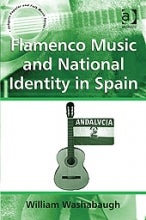Book Review: "Flamenco Music and National Identity in Spain" by William Washabaugh

Flamenco Music and National Identity in Spain
By William Washabaugh
Burlington, VT: Ashgate, 2012. 177 pp., bibliography, index. $89.95, hardcover
Despite its popularity in world music circles, its legibility as an exotic symbol of Spanishness and (last, but not least) its profound depth as a musical genre, only a handful of academic English-language books explore flamenco music and culture. Thankfully, we can now add another title to that small collection with William Washabaugh’s Flamenco Music and National Identity in Spain.
While the title refers to Spanish national identity, Washabaugh’s latest work revolves around the ways in which Andalusian authorities and institutions consistently reference flamenco in their efforts to frame and broadcast Andalusian nationhood. Andalusia, which was declared an autonomous community in February of 1980, is the southernmost region of Spain where a combination of Gypsy, Moorish, Sephardic, and autochthonous cultural elements coalesced in the early nineteenth century to form flamenco. This publication is especially valuable because it addresses many current issues regarding the popular representation and escalation of institutional involvement of flamenco in Andalusia. Unfortunately, the author was unable to discuss the inscription of flamenco onto UNESCO’s Representative List of the Intangible Cultural Heritage of Humanity at length due to the submission date of his manuscript (the third week of November 2010, the same week in which UNESCO’s declaration regarding flamenco was announced). However, the book does include a postscript section that provides the reader with a clean and concise summary of the implications of the UNESCO declaration.
In the first chapter, entitled “Heritage Music,” Washabaugh introduces us to his idea of a “hopeful future” for flamenco music and culture in which performance will spark widespread dialogue and an “opportunity for realizing Andalusian solidarity and autonomy” (2). Rather than highlighting performance practices or song forms, however, Flamenco Music and National Identity in Spain focuses mainly on the cultural and political implications of such aesthetics and performances. The author aims to create a new definition for flamenco by outlining what he calls the style’s telenomic, or “forward leaning,” characteristics and emphasizing its unifying capacities. Defining flamenco, however, is an extremely difficult task for several reasons.
Firstly, the word flamenco itself has many different meanings; it can refer to the music itself, the people that perform this music (known singularly as “a flamenco” or plural as several “flamencos”), a style of dress, or function as an adjective that describes a way of living and moving through the world. Even if we limit ourselves to the music itself, this encompasses three separate art forms, singing, guitar playing and dancing (which often presents a percussive component), as well as an extremely diverse (geographically, aesthetically and musically) set of song and dance styles. Several Spanish scholars, including Miguel Ángel Berlanga and Cristina Cruces Roldán, have recently called for a more precise, yet inclusive, definition of flamenco. This search, as Washabaugh points out in the book, has only intensified as the roles of government and international organizations in endorsing and marketing flamenco have expanded. In 2007, for example, the Andalusian Statute of Autonomy listed the conservation of flamenco as a guiding principle in public policy.
In chapter seven, aptly entitled “Autonomous Flamenco,” the author deftly navigates the myriad issues implicated within the institutionalization of flamenco. I was especially impressed with the ways in which he mapped out various agencies that fall within the dominion of the Andalusian government’s department of culture (92). Such specificity allows for a far more nuanced understanding of the administration’s methods, objectives, responsibilities, and accomplishments.
In order to construct a new definition for flamenco, Washabaugh identifies what he believes to be its three major philosophical underpinnings. Referring to them as the “three legs,” he cites the philosophies of krausism, modernism, and documentarism as the underlying political, artistic, and historical foundations for flamenco’s status as the cultural pride and musical patrimony of Andalusia (55). Drawing from historical records that include everything from the literature of Antonio Machado y Álvarez (Demófilo) to the musical works of Manuel de Falla and the documentary film series Rito y Geografía, the author explains how flamenco accumulated symbolic power and multiple meanings as an established cultural referent over the last one hundred and fifty years.
Washabaugh is clearly a cinephile and his passion for film, including his belief in its ability to recreate the world around us, shines through in this work. He references a wide variety of movies throughout the book and dedicates the entire eighth chapter to flamenco cinema. Such films, he argues, have the power to transform the ways in which viewers and listeners experience and conceptualize flamenco. While I do not disagree with this assertion, the author fails to relate any stories of specific artists or aficionados that were affected by these movies. As an ethnomusicologist, I cannot help but rue the absence of any extended ethnographic reporting. For example, while he boldly acknowledges that institutional effects upon flamenco music have been largely negligible (103-4), Washabaugh tends to understate the impact of individuals (and small groups of individuals) on communities of music makers and listeners.
Overall, this book is extremely useful because Washabaugh has an uncanny ability to locate, synthesize, and explicate a wide array of critical issues related to flamenco. He meticulously surveys both historical and contemporary readings, as well as video and audio recordings, in order to generate an analysis that is as encouraging as it is thoughtful in its prognostication.
References
Berlanga Fernández, Miguel. 2011. “Nuevas aproximaciones al Flamenco. Necesidad de teorías complementarias a las actuales. Sus repercusiones prácticas.” Paper presented at the First International Flamenco Congress, Seville, Spain, 11 November.
Parlamento de Andalucía. 2009. Estatuto de Autonomía para Andalucía. Seville, Sp: RC Impresores, S.C.A.
A brief introductory video on flamenco from UNESCO





